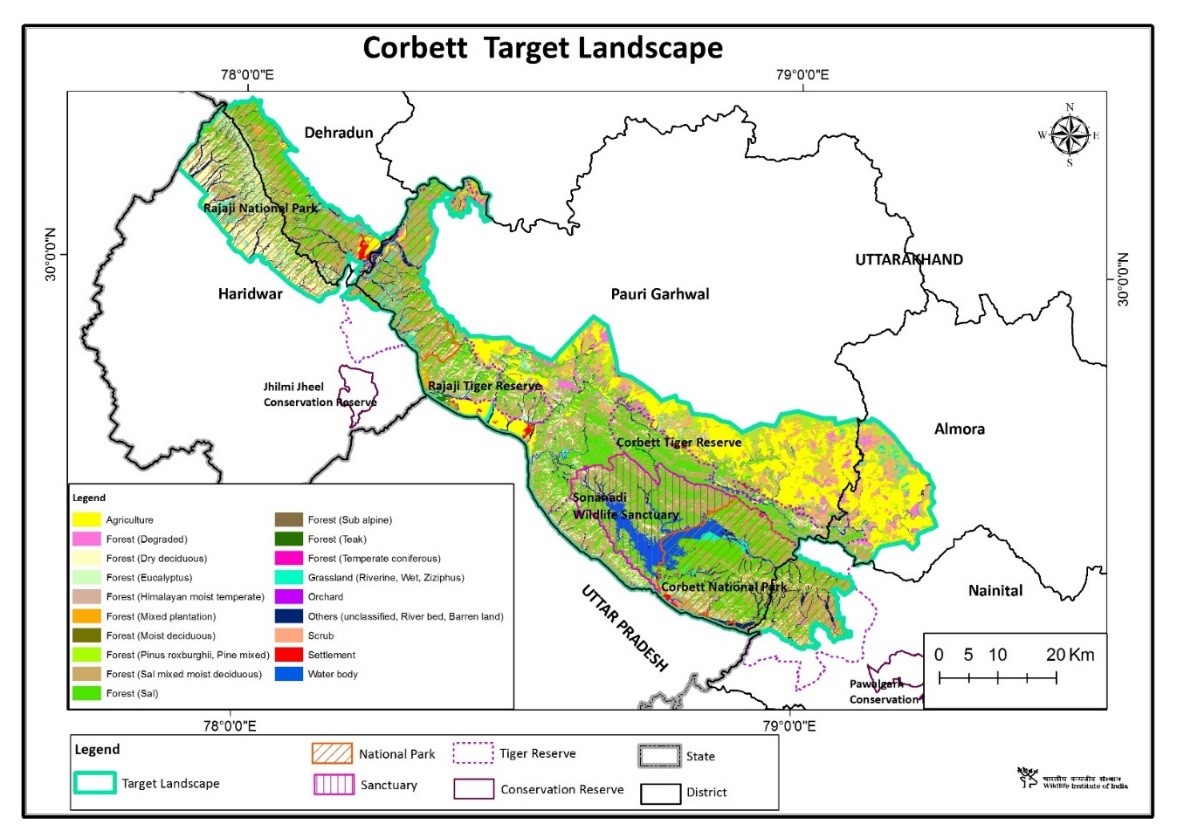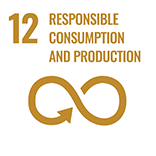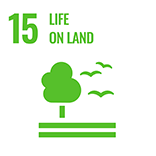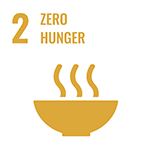Green-Ag: Transforming Indian Agriculture for Global Environmental Benefits and the Conservation of Critical Biodiversity and Forest Landscapes

Summary
This solution, implemented in the Corbett-Rajaji Landscape of the Uttarakhand state, is part of the “Green-Ag” project, a national project financed by the Global Environment Facility (GEF) and carried out in five different regions of India, each representing a Green Landscape of high ecological importance and environmental value.
The project is being implemented by the Food and Agriculture Organization (FAO) in collaboration with various government departments. Its overall objective is to “catalyse transformative change within India’s agricultural sector to support achievement of national and global environmental benefits and conservation of critical biodiversity and forest landscapes”. It therefore aims to equip local farmers with the necessary skills and incentives to maintain and/or adopt environmentally friendly agricultural and land use practices and collaborate to maintain and enhance global environmental benefits at the broader landscape level, simultaneously ensuring sustainability of agricultural production and enhancing rural livelihood development opportunities. In the longer term, it is intended to replicate the Green Landscapes approach at the national level in other protected areas and critical landscapes, so that critical ecosystem services that are fundamental to sustainable agriculture are secured.
The landscape of the Uttarakhand project provides an important corridor for wildlife, including the endangered Asian elephant and the Royal Bengal tiger. It falls into the Nainital, Pauri Garhwal, Almora, Dehradun and Haridwar districts. It is the only Green-Ag subregion located in a mountainous area.
All measures and activities are organized under two main components:
Component 1: Strengthening the enabling framework and institutional structures to mainstream biodiversity, sustainable land management, climate change mitigation, and sustainable forest management policies, priorities and practices into India’s agricultural sector.
Component 2: Improved agricultural and conservation practices demonstrating sustainable production, livelihood advancements, habitat improvements and delivery of tangible biodiversity, land degradation, climate change mitigation, and sustainable forest management benefits.
Overview
- Location:
- Implementation sites:
-
- Single country
- Multiple locations
- Mountain region:
-
Lesser Himalayas
- Province:
-
- Uttarakhand State
- Site locations:
-
Upland area of the Ramganga river watershed, Corbett-Rajaji wildlife corridor.
- Solution scale:
- Area Covered:
-
- 3247 km2
- Ecosystem type(s):
- Solution type(s):
- Climate impact(s) addressed:
- Other climate impact(s) addressed:
-
- Soil degradation, biodiversity loss
- Climate impact time-scale(s):
- Main benefit associated with the solution:
- Co-benefit(s) associated with the solution implementation:
- Implementation timeline:
-
- 2019 - 2026
Solution details
Main beneficiaries & outcomes
Through its various outputs, the project primarily benefits local communities, which in the Uttarakhand study region consists of 235 528 inhabitants, including 5 key ethnic groups. It will work closely with farmers and herders to help them improve their capacity to practice sustainable and climate-resilient production methods, and boost their livelihoods. Additionally, there will also be a particular focus on women’s groups.
The following outcomes are expected to be achieved:
- Outcome 1.1. – National and state level institutional, policy and programme frameworks strengthened to integrate environmental priorities into the agriculture sector to enhance delivery of global environmental benefits (GEB) across landscapes of highest conservation concern.
- Outcome 1.2. – Cross-sectoral knowledge management and decision-making systems at national and state levels to support development and implementation of agro-ecological approaches at landscape levels that deliver global environmental benefits as well as enhanced socioeconomic benefits..
- Outcome 2.1 – Institutional frameworks, mechanisms and capacities at District and Village levels to support decision-making and stakeholder participation in Green Landscape planning and management strengthened, with Green Landscape Management Plans developed and under implementation for target landscapes.
- Outcome 2.2 – Households and communities able and incentivized to engage in agro-ecological practices that deliver meaningful GEB at the landscape level in targeted high conservation priority landscapes.
Planning and implementation
The Green-Ag project is being implemented by the Food and Agriculture Organization (FAO) in collaboration with the Department of Agriculture, Cooperation & Farmers’ Welfare (DAC&FW) and the Ministry of Environment, Forest and Climate Change (MoEF&CC) of the Government of India. In Uttarakhand, the state governmental Department of Watershed Development is the agency in charge of execution.
To ensure the participation of different stakeholders and promote their involvement in the project activities, numerous consultation meetings and workshops were organized during the preparation phase. In Uttarakhand, the initial workshops were finally held in June 2020 after various delays. As in all other participating landscapes, a State Project Management Unit (SPMU) and a Green Landscape Implementation Unit (GLIU) were constituted. Furthermore, an Operations Manual containing the main implementation procedures and processes has been developed to facilitate implementation.
Finance
The entire project is being funded by various sources, such as the Global Environment Facility (GEF), FAO, and national and state government agencies (of the participating states) in India.
|
Project Preparation Grant Amount |
300,000 USD |
|
GEF Project Grant |
33,558,716 USD |
|
Co-financing Total |
868,390,000 USD |
|
199.36 million USD |
|
61.93 million USD |
|
131.16 million USD |
|
193.53 million USD |
|
279.21 million USD |
|
3.5 million USD |
|
GEF Agency Fees |
3,020,284 USD |
|
TOTAL COST |
902,248,716.00 USD |
Source: GEF, 2021.
Of the total GEF grant allocated to the project, $5,926,794 is being committed to measures in the Uttarakhand landscape.
Innovation
The innovative aspect of this project is related to its focus on an integrated multi-sectorial approach for mainstreaming global environmental concerns into agriculture programmes, policies, capacity building actions, and landscape management. To this end, it looks for the creation of an improved management regime designed for maintaining ecosystem services at a landscape scale.
Moreover, the solution also plans for the employment of innovative technology, such as the Collet Earth software which serves to improve land use monitoring and analysis using satellite data, and approaches such as outcome based planning in agriculture.
Performance evaluation
The design of this project includes robust monitoring and reporting components that will be carried out in accordance with FAO, GEF and Government of India procedures. The following reports will be produced:
- Project inception report
- Annual work plan and budget
- Project progress reports
- Annual project implementation report
- Technical reports
- Co-financing reports
- Terminal report
Furthermore, a mid-term evaluation is planned to be conducted on September 2022 to review the project’s progress towards achieving objectives, outcomes and outputs, the effectiveness of partnership arrangements, and to identify issues that might require remedial actions. An independent final evaluation is also planned for December 2025 to identify the project’s impacts, the sustainability of results, and assess the achievement of long-term results.
Long term project sustainability and maintenance
The long-term environmental, social and economic sustainability of solutions is sought through several actions that can be summarized in the following descriptions:
Environmental sustainability – Efforts to remove major barriers to degradation vulnerabilities and pursue the conservation of biodiversity and natural ecological functionality. The continued mainstreaming of environmental concerns into the agriculture sector will also be encouraged.
Social sustainability – Ensured by strengthening institutional capacity building efforts at national, state, district and local levels through the design of training programs during implementation and carried out after the project. This is further supported by established project activities and outputs such as output 1.1.1 and 2.1.1. Likewise, high local ownership is being pursued.
Financial sustainability – The Government of India is expected to continue to make significant investments in agriculture, environment and development at the local level. Also, replication and scaling up of strategies will be promoted.
Finally, sustainability beyond project completion is to also be supported by the creation of the official project website (https://greenag.nmsa.gov.in/), where key summaries, reports and lessons will be shared.
Capacities for design and implementation
Knowledge
The Green-Ag project uses existing international, national and state knowledge that is relevant for on-site planning of biodiversity conservation and sustainable land, water and forest management. The available information is useful, among other things, for strategies such as the generation of online maps showing the locations of critical habitats, current protected areas, community-managed forests and other ecosystems, key degraded areas, and locations of government and community infrastructure.
In the case of indigenous knowledge, Biodiversity Management Committees (BMCs) will be supported to document this type of knowledge and its use in community natural resource management plans.
Technology
Some available technologies, such as remote sensing and geographic information systems, have been useful for the development of a landscape assessment that collected key baseline data on weather conditions, land cover and land use change, terrain characteristics, water bodies, forest cover, cropping patterns, population characteristics, etc.
In addition, existing electronic tools, such as the Farmer’s Portal (a national government website that provides a “one-stop shop for farmers”), Digital India (a government program designed to promote e-governance), Kisan Call Centers (a national toll-free number that connects farmers with national agricultural specialists), and Digital Green (an NGO that links technology and social organizations to improve agriculture, health, and nutrition), have been identified as useful and will be promoted where appropriate.
Political / Legal
Actions in the Uttarakhand landscape are receiving significant support from national, state and local government departments. Meanwhile, the project in the state is aligned with the State Climate Change Action Plan and Uttarakhand’s Vision 2022 towards robust growth and inclusive development, which promotes, among other things, positioning the state as a national leader in organic agriculture and to foster agricultural research adapted to local conditions.
At the national level, the project is aligned to various key policies and strategies, including the Indian National Biodiversity Action Plan (NBAP), National Action Plan on Climate Change (NAPCC), National Mission on Sustainable Agriculture (NMSA), National Water Mission, National Mission on Strategic Knowledge for Climate Change (NMSKCC), Green India Mission (GIM), Forest Conservation Act, and the National Action Programme to Combat Desertification, Land Degradation and Drought of 2015-2030.
Institutional
As a strategy to build the necessary institutional capacities and promote resource and knowledge sharing, the project aims to strengthen organizational capacities, such as cross-sectoral and multi-stakeholder collaboration and coordination mechanisms, and has established cross-sectoral working groups at different levels. In this case, FAO’s operational partner implementation modality is being used in all five landscapes. In the state of Uttarakhand, the Watershed Management Directorate serves as the operational partner.
The private sector is engaged in policy dialogues and other multi-stakeholder platforms at the state and national levels to influence policies and investments.
Socio-cultural
Engagement with local communities and institutions in the project region is very important for the planning and implementation of actions. It was, for example, a relevant aspect in the development of the landscape assessment through direct consultations and focus group discussions, and will prove very valuable for the implementation of solutions through community-led actions and initiatives. The project therefore plans to develop the know-how and skills of individual farmers, households and communities to implement new agroecological farming practices, including climate resilient ones.
The project planning includes a capacity enhancement risk analysis as well as a stakeholder analysis.
Outlook & Scalability
Barriers and adverse effects
One of the major difficulties the project has faced is the COVID-19 pandemic, which severely restricted community participation activities and resulted in the delay of several planned activities. In addition, frequent changes of chairperson in the National Project Monitoring Committee, high staff turnover, and spread of the COVID-19 virus among the project personnel despite precautionary measures also affected. In Uttarakhand, political instabilities and the change of chief minister and cabinet ministers hampered and delayed the progress of the project. The initial workshop finally materialized in June 2020.
Finally, the rules and procedures of the Operational Partner Implementation Modality (OPIM) and FAO rules and regulations were considered rigid.
Transformation and future outlook
In Uttarakhand, the project supports fundamental change by promoting sustainable agriculture, land, livestock and forest management, as well as other biodiversity conservation efforts. It will seek to protect water resources and promote the development of a watershed management plan. In addition, work will be undertaken in collaboration with stakeholders and local people to, among other things, support actions that assist in mitigating human-wildlife conflicts and to help communities adopt good agricultural practices (GAP). Such actions are expected not only to reduce human pressures on natural ecosystems, but also to provide skills and knowledge that will strengthen their adaptive capacities and reduce vulnerability.
Potential for upscaling and replication
According to the information available, no replication actions have yet been carried out. However, the project plans to expand or replicate the solutions tested in other regions of the country in the future. To this end, the development of regular project reports and evaluations will be essential, as well as the dissemination of lessons learned via various tools (e.g., the official project website).
Throughout the duration of the project, major efforts are planned for supporting the integration of environmental issues into agricultural policies, plans and investments, and for harmonizing the agricultural and environmental sectors in the country.







Comments
There is no content